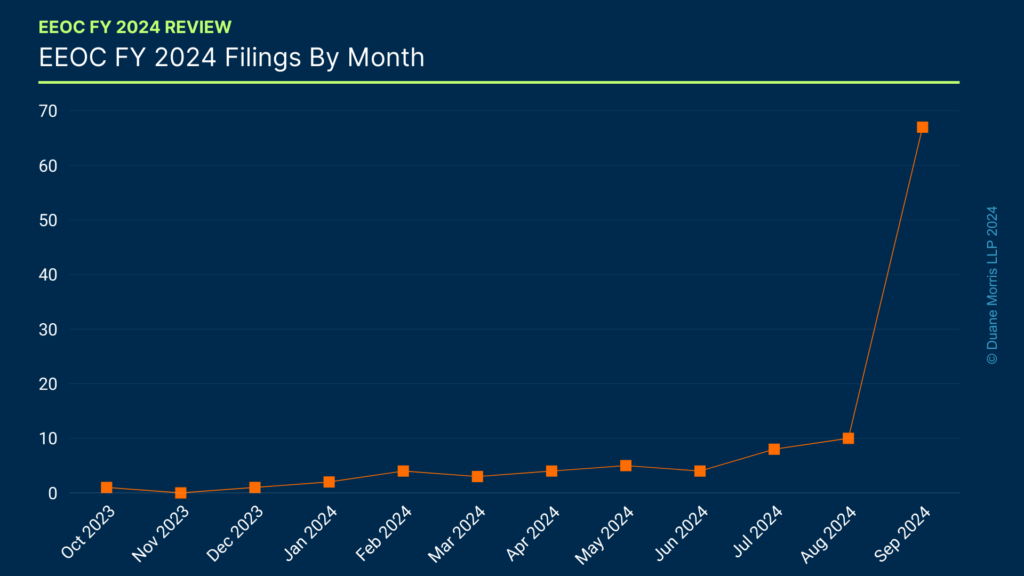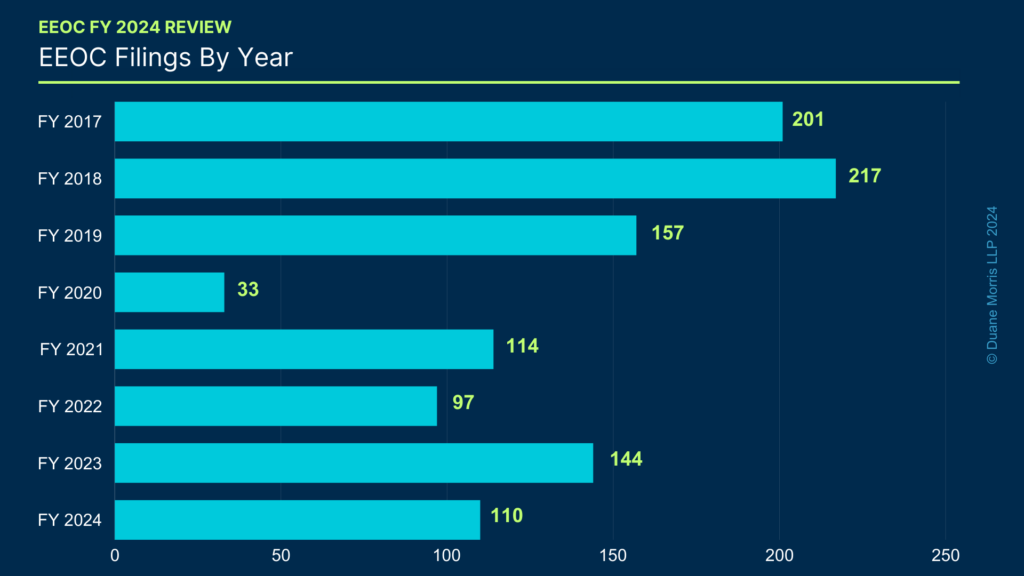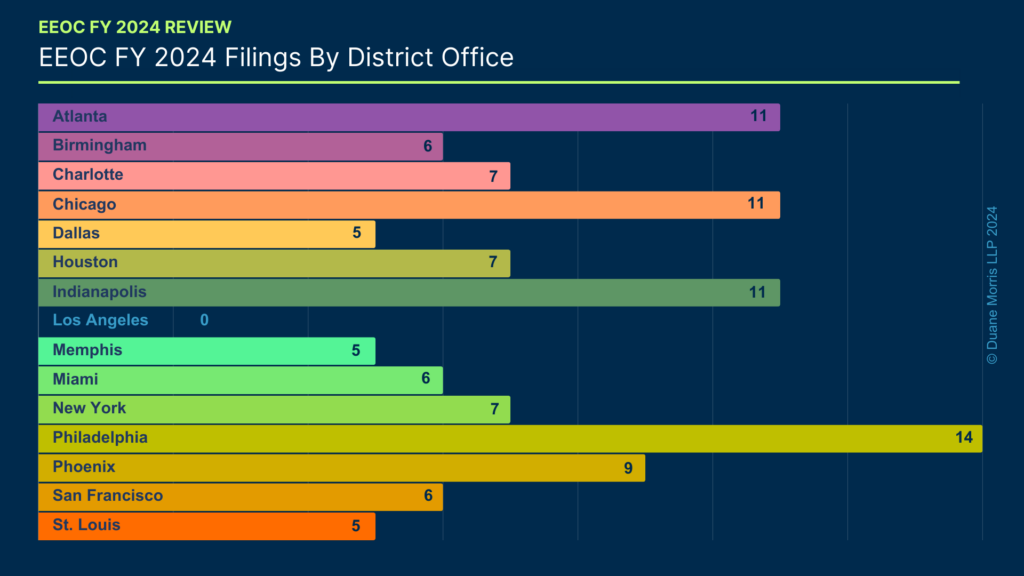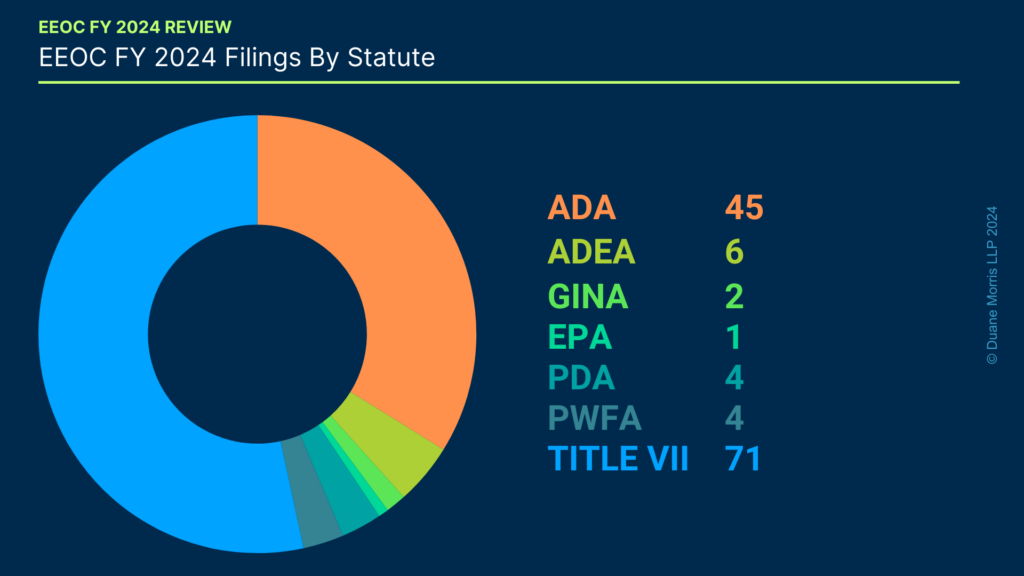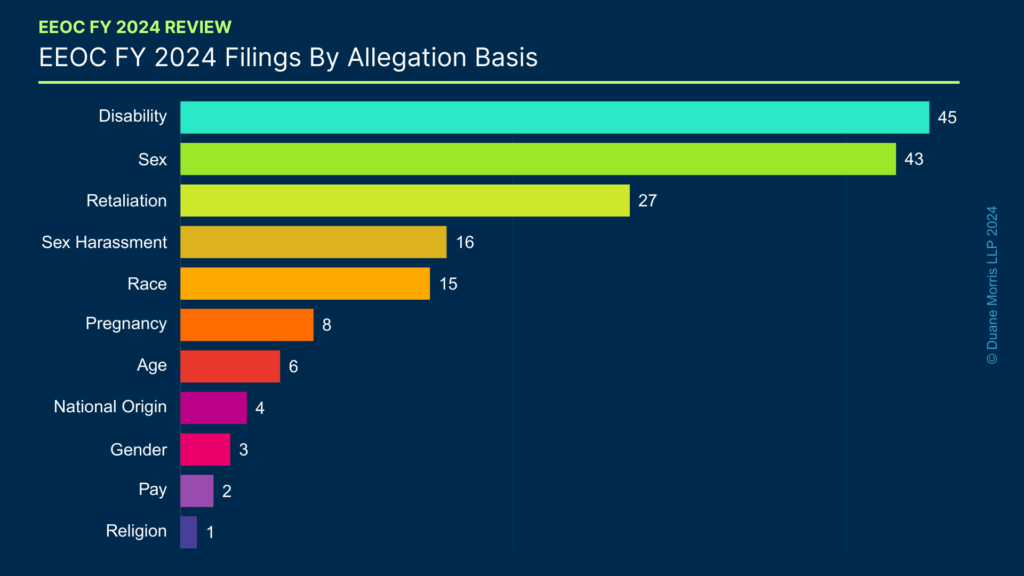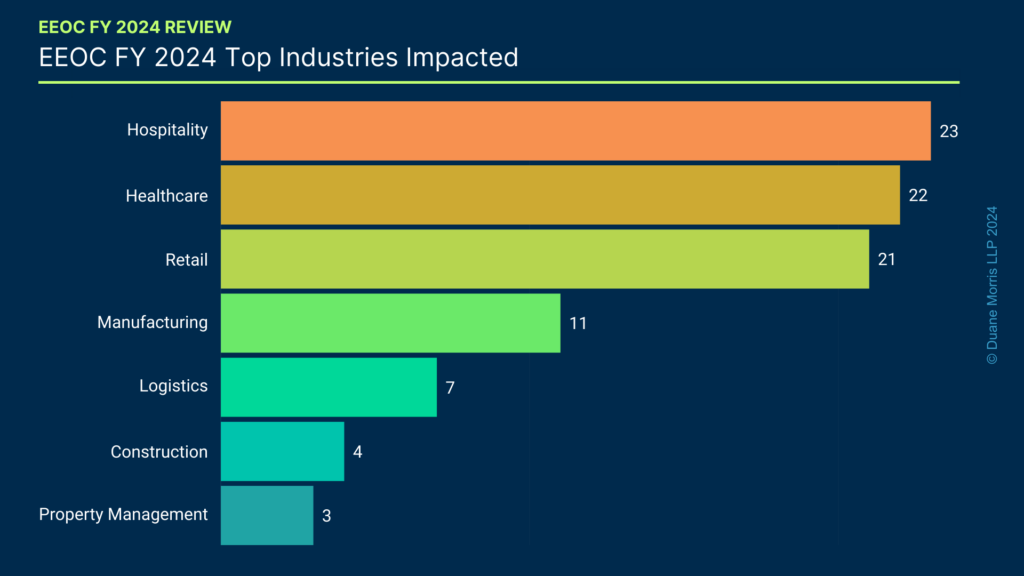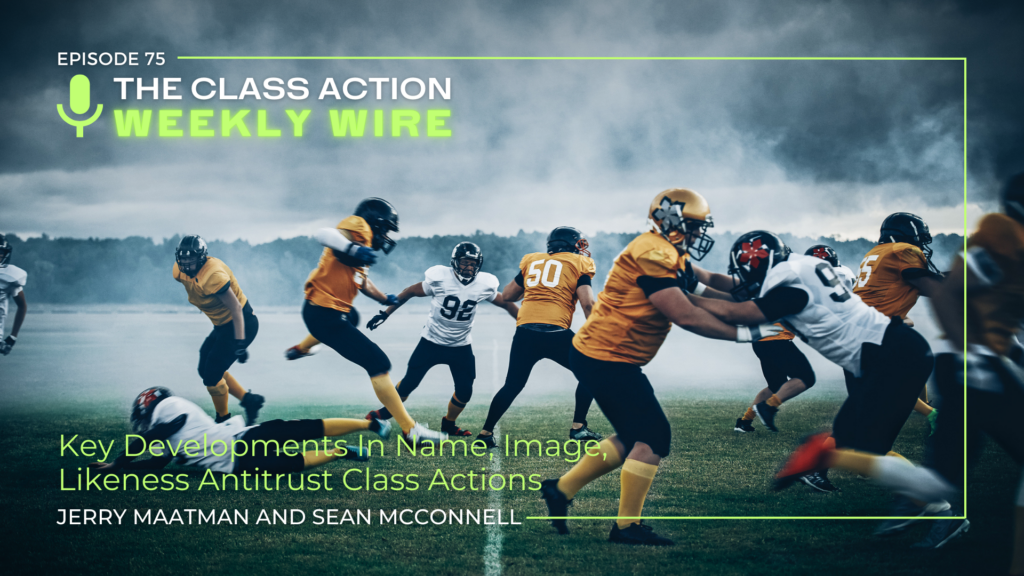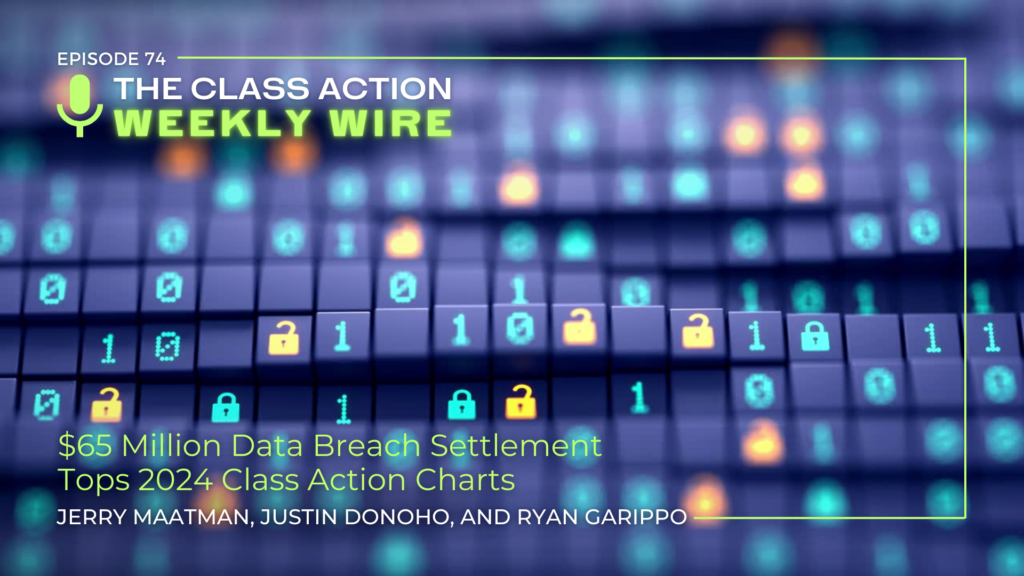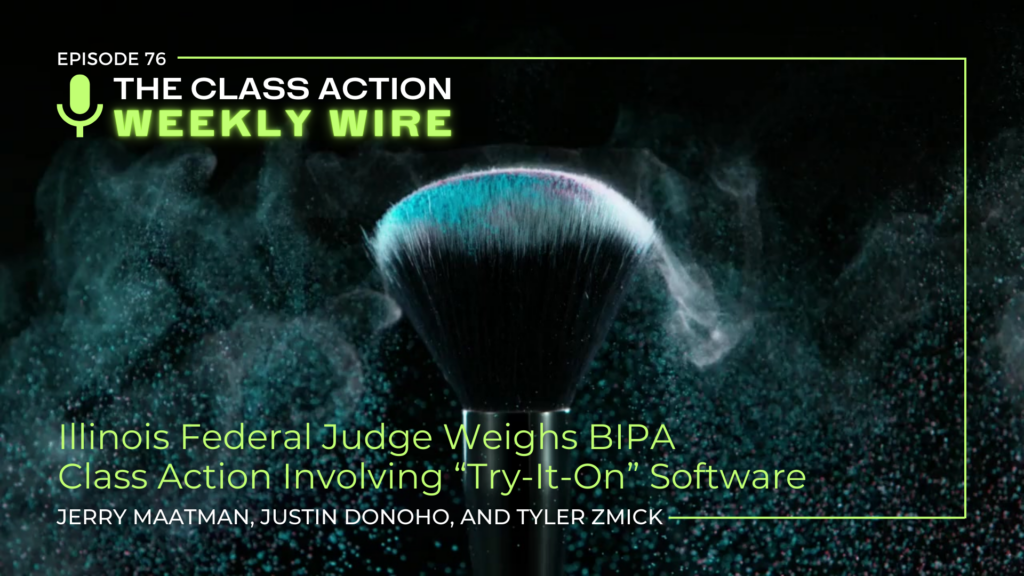
Duane Morris Takeaway: This week’s episode of the Class Action Weekly Wire features Duane Morris partner Jerry Maatman, special counsel Justin Donoho, and associate Tyler Zmick with their discussion of a BIPA ruling issued in the Northern District of Illinois analyzing the arguments of consumer privacy claims involving virtual “try-on” technology.
Check out today’s episode and subscribe to our show from your preferred podcast platform: Spotify, Amazon Music, Apple Podcasts, Samsung Podcasts, Podcast Index, Tune In, Listen Notes, iHeartRadio, Deezer, and YouTube.
Episode Transcript
Jerry Maatman: Thank you, loyal blog readers for joining us on this week’s installment of our podcast series, entitled The Class Action Weekly Wire. Today I am joined by my colleagues, Justin and Tyler, and we’re going to talk about all things BIPA. Justin and Tyler, welcome to the show.
Justin Donoho: Thanks, Jerry, happy to be here.
Tyler Zmick: Thank you for having me, Jerry.
Jerry: Today we’re discussing a lawsuit brought under the Illinois Biometric Information Privacy Act involving cosmetics manufacturer L’Oréal, and a ruling that emanated from the U.S. District Court for the Northern District of Illinois. Justin, could you give our readers and listeners an overview of the allegations at issue in this lawsuit?
Justin: Yes, Jerry, so this is another challenge under BIPA to virtual try-on software. We’ve seen a number of these filed against cosmetic companies. The way the software works is you’re viewing the cosmetic product on the web page, a pop up then appears, allowing you to use your web or phone cameras to upload a photo to check how the product will work on your face. And then, according to plaintiffs, the virtual try-on software then allegedly captures what the plaintiffs contend is a “scan of facial geometry” in the consumer’s photos – or you know, what that means under BIPA is a scan of sufficient geometry of the face, to be unique to the individual, and to be capable of identifying a person.
Jerry: These sorts of try-on BIPA cases are being litigated more frequently. If we talked about BIPA litigation five years ago, it typically would involve a timekeeping system and workers who checked in and checked out of work through biometric identifiers. Here, however, we’re talking about customers interacting with software. Tyler, you have quite a bit of experience in the BIPA field and space – what did you find significant in the way in which the defendant in this litigation tried to argue its motion to dismiss?
Tyler: Sure. Well, I think there were three main arguments that L’Oréal raised in its motion to dismiss. The first was that it wasn’t really a substantive argument, it was procedural, and the argument was that by using the virtual try-on tool, the plaintiff agreed to the company’s terms of use, which contain an enforceable arbitration provision. And so the argument was that this plaintiff cannot bring a class action, but must bring an individual claim in arbitration. The court rejected that argument, finding that the plaintiff did not get conspicuous enough notice. As for the substantive arguments under BIPA, L’Oréal argued that according to its privacy policy, which was presented to plaintiff, the plaintiff consented to the categories of personal information being collected from users, including plaintiff, who use the virtual try-on tool, and the language said that “if you use one of our virtual try-on features, we may collect and store your images.” And so obviously the court found that language deficient because it did not specifically address biometric information or scans of facial geometry obtained from an image. And finally, as with many defendants moving to dismiss BIPA claims, L’Oréal argued that plaintiff failed to state a claim because the complaint failed to establish the company was in possession of any biometric data, and that their technology only operates locally on users’ devices.
Jerry: I know that facts drive case decisions, but it seems that BIPA cases have gone both ways on this issue or the array of issues you just articulated in the Northern District of Illinois. How did the court rule in this particular situation?
Justin: Yes, Jerry. Interestingly, you say both ways. So yes, at least at the at the motion to dismiss stage, anyway, the courts do seem to be going both ways on these virtual try-on cosmetic cases on the key issue of whether what is being captured is sufficient facial geometry to be a unique biometric identifier. There have been a number of other cases, too, like this that also do not involve facial recognition like interview software, a pornography filter that happens to filter photos that contain a face, passport photo software, COVID screening – basically, if your company has a technology involving a face in any way and some arguable connection to Illinois, then the plaintiffs’ bar is suing, or it may have you in its crosshairs. So in this case, though there was no written decision. But it does appear, though, that this court did not rule on this key issue of whether the software captured a biometric identifier because the parties didn’t argue it in their briefs in this particular case. We’ll have to wait to see how that issue comes out if the parties ever get to the expert discovery and summary judgment stage, where likely this will become the parties main focus. So Tyler mentioned the three kind of main arguments that the defendants made in this case in their motion on. I’ll just do the first one – the main focus was the arbitration clause. By denying the motion to dismiss the court basically ruled that even though this was clickwrap instead of browsewrap, the arbitration clause in this particular instance, was not conspicuous enough for the plaintiffs to be bound, or, in other words, clicking to accept things that plaintiffs may have done was on other things, and too far removed from the terms of the arbitration agreement.
Tyler: And one more point – L’Oréal did not develop this argument – specifically the argument that the technology did not collect unique scans of face geometry – but it was addressed in passing in the briefing on the motion dismiss, and the judge basically rejected that argument, at least at the motion to dismiss stage. And the court ruled that plaintiff sufficiently alleged that the way the try-on tool works is by processing the user’s image and capturing facial geometry to identify their features, and thus the reasonable inferences of the company collected biometric data that is necessary for the tool to work. And so I think, even if the technology does not ultimately work in a way that it can uniquely identify specific individuals, that is an uphill battle to present that argument early at the pleading stage, and summary judgment may be more appropriate for that type of argument.
Jerry: Well, certainly the ruling and the case is incredibly interesting, and it underscores the innovative thinking of the plaintiffs’ bar and attacks on all sorts of customer interfacing software that has anything to do with collection of alleged biometric information. It also underscores how important consent features are in terms of a company interacting with its customers because consent – obviously the bedrock principle under BIPA – to try and get the consent to allow a collection I f there’s any question that biometrics are involved. Well, thank you for your thought leadership, Justin and Tyler, and for lending your expertise to describe this ruling. Thank you, listeners, for joining us on this week’s episode of the Class Action Weekly Wire.
Justin: Thanks, Jerry.
Tyler: Thank you everyone for tuning in.



